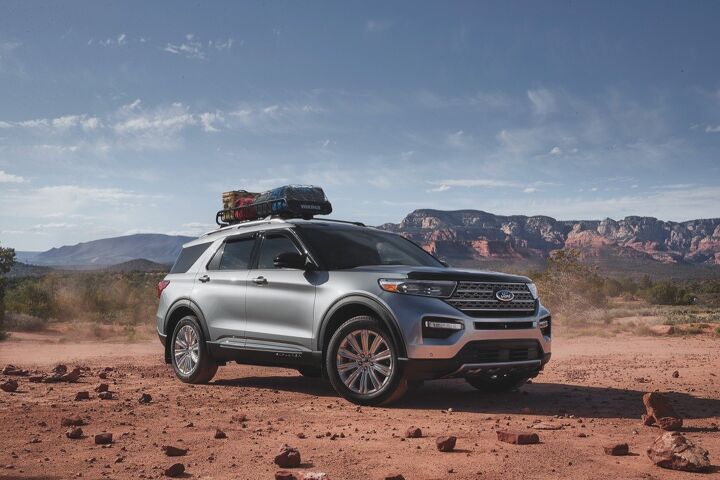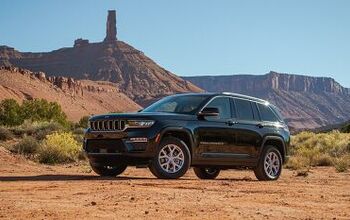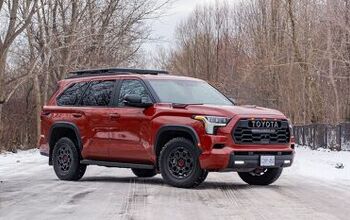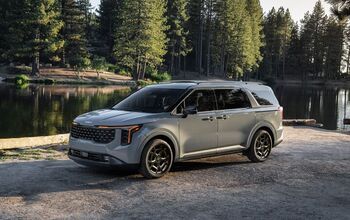Ford Explorer XLT Vs Limited: Which Trim is Right for You?

The Ford Explorer remains one of the brand's most enduring—and best-selling—SUVs.
When it debuted back in 1991, the Explorer served as a preview of the high-rider future. It sat on a modified truck platform and well, it drove like one. Fast forward to today's sixth-generation model and the Explorer has a much more road-friendly ride. Nonetheless, it still stands apart from most of the mid-sized segment, as it sits on a rear-biased platform, not front-drive-based. For those moving out of trucks, that similarity provides a comfortable familiarity.
Like a truck, the Explorer comes in plenty of trims, ranging from frugal to fancy. For this trim-on-trim comparison, we're focusing in on two of the more popular flavors. Stuck on which is the right one for you? Read on for our full Ford Explorer XLT versus Limited comparison.
Style
The Explorer is one of the few mainstream rear-drive-based SUVs out there. That gives subtly different proportions from the competition, with an emphasis on a long hood and short front overhang. The Explorer has a rugged, upright stance, with a bluff front-end incorporating simple, rectangular headlights and hexagonal grille. A strong shoulder line and reverse-rake C-pillar keep the Explorer looking like, well, an Explorer.
There are a few key styling differences between the Explorer XLT and Limited. The former keeps much of its trim simple black plastic, including most of the grille, the lower bumper, corner air intakes, and roof rails. The Limited glitzes the joint up with a chrome-tactic grille, contrasting “skid plate,” front fog lights, and metallic roof rails. An option package does provide the fog lamps and faux skid plate for the XLT, if you’re so inclined. Limited buyers also gain a redesigned rear bumper with two chrome exhaust tips, and 20-inch alloy wheels; 18s are standard on XLT.
[detroit-new-car class="dt-new-car-quote" make=“ford” model=“explorer”][/detroit-new-car]
Ford Explorer XLT vs Limited: Cabin Space
As one of the largest options in this segment—coming in just shy of 199 inches (5,055 millimetres)—the Explorer has a spacious three-row cabin. The front two rows are more than comfortable for adults, and both trims have the choice of second-row captain’s chairs or a three-wide bench. Even the third row is one of the friendlier ones in the segment, with 38.9 inches (988 mm) of headroom and 32.2 inches (818 mm) of legroom.
The general look of the cabin is the same in both Explorer trims. The Limited features unique center console trim pieces, and a general increase in the amount of chrome-look bits. It’s the seating that changes: the XLT has standard cloth or optional, easy-clean ActiveX materials, while the Limited moves up to leather. While both models offer front-row heated seats, the Limited bolsters that with ventilation, and second-row outboard heated seats. Speaking of bolstering, the driver’s seat is 10-way power-adjustable in both trims; the Limited has standard eight-way power adjustability for the front passenger, which is optional on XLT.
Powertrain and Fuel Economy
Both the Explorer XLT and Limited come equipped with Ford’s 2.3-liter EcoBoost turbo-four. This is one of the strongest base engines in the segment, producing an even 300 horsepower and stout 310 pound-feet of torque. A 10-speed automatic sends power to the rear axle as standard, with an available four-wheel drive system optional.
Fuel economy figures are 21 mpg city and 28 mpg highway, for a 24 mpg combined rating. Skipping the start-stop feature knocks the city and combined figures down by 1 mpg. Opt for 4WD—which is standard in Canada—and you’re looking at 20/27/23 mpg, respectively. (Canadian figures are 11.6/8.7/10.3 L/100 km.) Again, removing start-stop makes for slightly worse figures.
The Explorer Limited is also available with a hybrid. This swaps in a naturally-aspirated 3.3-liter V6 engine with electric motor assist. Power is up slightly, to 318 hp and 322 lb-ft. Efficiency doesn’t take a Toyota-like jump, with the rear-drive model matching the gas SUV’s 28 mpg highway figure, but improving the city rating to 27 mpg (which is also the combined rating). The Hybrid 4WD model has a smaller advantage: 23 mpg city, 26 mpg highway, and 25 mpg combined. (Canadian scores: 10.1, 9.0, and 9.6 L/100 km).
Towing capacity for the turbo-four tops out at 5,300 pounds (2,404 kilograms) when properly equipped. The hybrid does slightly worse, at 5,000 lb (2,268 kg).
Ford Explorer XLT vs Limited: Safety
Both of these Explorer trims—and in fact, all Explorers—come with Ford Co-Pilot360 as standard. This suite of driver assists includes auto high beams, a lane-keep assist, auto headlamps, blind spot monitoring with cross-traffic alert, and pre-collision assist. Hill start assist is also included, as is post-collision braking, rear parking sensors, and a trailer sway control feature.
The XLT offers an available tech package that includes a 360-degree camera, as well as a Co-Pilot360 Assist+ package that brings adaptive cruise control, evasive steering assist, and voice-activated navigation to the party.
The Limited includes the Assist+ package as standard equipment.
Technology and Features
The Explorer XLT shows up with standard trip-zone climate control, Ford’s MyKey system, four 12V outlets, and four USB ports. The infotainment screen is an 8.0-inch setup running SYNC 3 with 4G hot-spot capability, and the sound system uses six speakers. Buyers have the option to double that speaker count to a dozen Bang & Olufsen units with a tech package. Other options include navigation, SiriusXM, a heated steering wheel, 360-degree camera, universal garage door opener, wireless charge pad, and more.
All of those optional features mentioned above come standard on the Limited. The XLT also adds ambient lighting. Its options include available driver memory seating, power-adjustable steering wheel, 110V/150W AC power outlet, and a power-folding third row. A Limited Technology package expands the touchscreen to 10.1 inches, and another audio upgrade to a 14-speaker B&O setup.
Both models offer the standalone option of a two-panel moonroof.
Ford Explorer XLT vs Limited: Pricing
The 2023 Ford Explorer XLT RWD kicks off at $40,165 including destination. The 4WD model lists from $42,165 ($50,535 CAD). The Limited RWD bumps that up to $49,015, or $51,015 ($57,480 CAD) for 4WD. Want a Limited Hybrid 4WD? That’s a tough, $56,950 ($62,480 CAD) pill to swallow.
Options can add thousands to the bottom line: it’s possible to get the XLT past the Limited’s price tag, for example.
Ford Explorer XLT vs Limited: Verdict
The Explorer offers a more rugged, hearty, boat-pulling sort of SUV experience than many of its front-drive-based competitors. The XLT and Limited provide two great mid-level trims with lots of modern amenities, even if none of them are particularly stand-outs at this price. Just skip the hybrid: it offers very small efficiency gains for a huge up-front cost.
We appreciate Ford offering numerous packages on the XLT to tailor it to buyers’ needs. Sticking to the stock setup, or adding just one or two packages, is the smart play for us, keeping the Explorer reasonably affordable while packing it with modern touches. If you’re going to be adding more than that to the XLT, it makes much more sense to opt for the Limited. We don’t love those big, road-oriented tires, but the Limited offers up unique passenger amenities, like second-row heated seats and front-row ventilation, that just can’t be bought in XLT-land. Move much beyond the $50,000 line ($58,000 CAD), and you’re better served looking at the premium brands, including the related Lincoln Aviator.
Become an AutoGuide insider. Get the latest from the automotive world first by subscribing to our newsletter here.

Kyle began his automotive obsession before he even started school, courtesy of a remote control Porsche and various LEGO sets. He later studied advertising and graphic design at Humber College, which led him to writing about cars (both real and digital). He is now a proud member of the Automobile Journalists Association of Canada (AJAC), where he was the Journalist of the Year runner-up for 2021.
More by Kyle Patrick







































Comments
Join the conversation